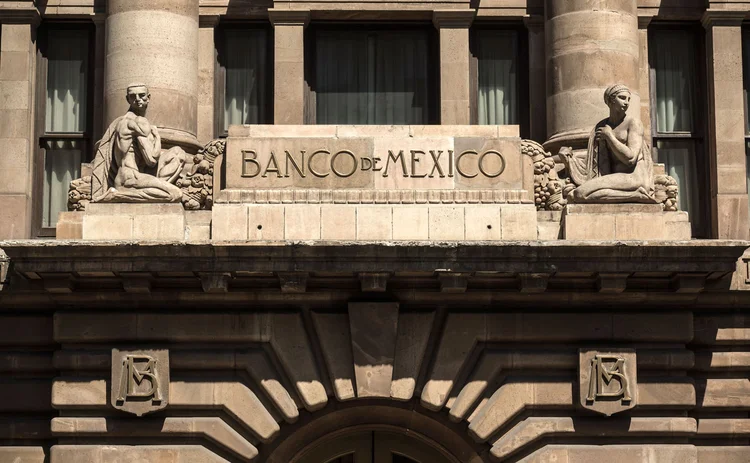
Reserve manager of the year: Bank of Mexico
The Latin American central bank has adopted a forward-looking asset allocation strategy as well as embracing absolute return approaches

The Bank of Mexico has successfully modified its strategic asset allocation process in recent years, transitioning from simple models that base portfolio optimisation on historical information, to more complex and prospective models that allow the central bank to better comply with its liquidity and capital preservation objectives. In particular, in 2018, the central bank embarked on the challenging task of re-evaluating the statistical methodologies and the inputs used to better reflect market perspectives and the co-dependency in financial markets. The Bank of Mexico has also broken new ground by investing in absolute return strategies in addition to its existing investments.
The rise in raw material prices during the commodities ‘super-cycle’, from 2000 to 2012, benefited oil exporters such as Mexico. In this period, international reserves at the Bank of Mexico rose to $164 billion in December 2012 from $31 billion in January 2000. However, the cost of carry on the international reserves portfolio was quite high. Therefore, the central bank focused its strategic asset allocation to enhance returns on its portfolio.

“The idea was to expand the investment guidelines to include new asset classes that could enhance the expected return of the international reserve assets without significantly increasing the market risk,” says Gerardo García, director of international operations at the central bank.
To accomplish these objectives, the central bank used a mean-variance benchmarking approach based on historical data and the assumption that the distribution of returns is symmetric to assess its risk exposure. This strategy facilitated the introduction of gold, currencies such as Australian and New Zealand dollars, inflation-linked debt, asset-backed securities and debt issued by international organisations and non-US governments into the Bank of Mexico’s investment portfolio.
In 2013 and through 2017, however, the expected evolution of the global macroeconomic environment prompted the central bank to focus more intensively on capital preservation. “We realised that we would be facing new challenges for reserve management” says Andrea San Martín, manager of the foreign markets analysis division at the central bank.
“It became our expectation that the Federal Reserve could commence its monetary policy normalisation, which would likely lead to a rising interest rate scenario, and an appreciation of the US dollar,” adds García. “As a consequence, our exposure to other currencies could result in an immediate capital loss. In addition, an increase in interest rates could also pose a risk to the portfolio’s returns.”
Defensive strategy
San Martín says that during this period, the Bank of Mexico’s reserve accumulation “had come to a halt”, given the lower oil prices, and there was “a possibility that we may need to use international reserves to provide liquidity to the market, which in fact happened”. As a result, international reserves declined to $173 billion as of the close of 2017, from a peak of $196 billion in 2015. As a result, the central bank prioritised capital preservation, by identifying the main risk factors in its portfolio and adding forward-looking measures to its optimisation models, moving from a historical approach to a Bayesian model. The results prompted the central bank to reduce the duration of its sovereign debt portfolio. It also cut its exposure to non-US dollar assets.
A new approach
Although from 2013 to 2017, the Bank of Mexico had already moved to optimisation models in which staff could combine historical and forward-looking data to construct reference portfolios, those models still had drawbacks as they assumed symmetric individual and joint distributions of asset returns.
“Evidence shows that returns tend to behave in non-normal distributions – they have fatter tails. You need to account for that if you’re focused on preserving capital on your reserves portfolio. In that sense, in 2018, we changed the assumption of how assets behave and the interaction between them,” says García.
To do this, the Bank of Mexico decided to model asset returns through the use of non-parametric distributions (kernels), and increased its interlinkages of the interdependence of asset prices by estimating probability functions that best represent their interdependence or joint distributions using copulas. On top of this, the new asset allocation benchmark has a forward-looking component guided by market data analysis, rather than just by historical datasets. “Looking back is quite different to looking forward. We do not want to optimise the portfolio looking only at historical returns” says San Martín.

As such, in determining the exact strategic asset allocation, the reserve department added available market data into the asset price forecasts. However, “to avoid a highly subjective estimation of asset returns”, the calculation of expected distributions “was obtained from the information implicit in market instruments for a one-year horizon – in most cases, options”, says Rafael Jiménez, deputy manager for analysis at the Bank of Mexico: “We believe that is consistent with the assumption that markets are efficient and that all available information is already incorporated into the asset prices.”
As in any model, certain restrictions were imposed to avoid corner solutions or portfolios that were not feasible. “There are some things that our model does not know, such as the depth and liquidity of the markets, the feasibility of investment, the profile of an international reserves portfolio, among other important issues,” says San Martín. “For that reason, we needed to consider some constraints. To have a better-educated idea of the restrictions we should impose, we conducted different scenario analyses that guided the limits that we wanted to impose to each of the assets.”
As a result, the reserves team put in place some qualitative constraints related to appropriateness for a central bank reserve investor. At an asset level, this included at least some exposure to all segments of the US Treasury curve, investment in reserve currencies and marginal increases in non-reserve currency assets.
Furthermore, the Bank of Mexico decided to use conditional value-at-risk (CVaR) models, instead of volatility-based models. The new approach is meant to measure the expected loss if a worst-case threshold is ever crossed, and, in that sense, they are more consistent with the goal of capital preservation.
The result of the Bank of Mexico’s new optimisation model based on non-normal distributions of returns, co-dependence between assets and qualitative constraints, is a benchmark portfolio with a similar expected return to its previous portfolio, but a much narrower expected distribution of returns with a lower likelihood of underperformance under extreme circumstances.

While still to face extreme tests, the new benchmark appears to be more likely to perform well in different economic scenarios, as it is exposed to asset classes that will benefit from both higher or lower growth and inflation scenarios, argues the central bank. In comparison to 2012, the 2018 benchmark includes a larger proportion of assets to US floating rate notes, cash and cash equivalents in both US dollar and other currencies. “We have more asset classes and currencies than before, reflecting that diversification is consistent with the ultimate objective of capital preservation,” says San Martín.
“We now have a more robust, transparent and forward-looking methodology to take the most important decision of any reserve manager: its strategic asset allocation,” says García.
The adoption of new methodologies for asset allocation was facilitated by a change in the organisational structure of the central bank that allowed the creation of the foreign markets analysis division in 2015. This division focuses on the strategic and asset allocation for the international reserves portfolio. In addition, although the Bank of Mexico cares about long-term capital preservation, the reserve management department is able to review the composition of its benchmark every year – or more frequently if it is deemed necessary. Such an approach has given the Bank of Mexico flexibility to adopt new methodologies and to adapt to the ever-changing financial market conditions. Its latest framework has been positively received by other central banks, and the Bank of Mexico has developed externships to help other institutions to develop their own strategies.
“The Bank of Mexico’s strategic asset allocation framework is very dynamic, as it considers shifts in their objectives depending on the market environment,” says a reserve manager at an Asian central bank. “The use of CVaR, which focuses on tail risks, is also consistent with the objective of capital preservation. This strategy may be considered in the next review of our framework.”
Absolute returns
On the other hand, aware that benchmark constraints can expose portfolio managers to risks they may not always want to bear – in particular to a sudden increase of interest rates – the Bank of Mexico broke new ground in 2017/2018 by awarding three absolute return strategy mandates to external managers.
“We felt that we could further diversify the portfolio by including investment strategies that are seldom used by central banks, but that could hold low or negative correlations with our current portfolio: an absolute return portfolio,” says García.
The aim was to create absolute return strategies so portfolio managers could make investment decisions based on their “highest conviction”, García tells Central Banking. Managers can also thoroughly exploit the universe of eligible asset classes and be very flexible under changing market dynamics, the central bank argues. In fact, the absolute return managers can take positions that are not currently available to Bank of Mexico staff (they are eligible, but the staff are not ready to invest in them), effectively pushing out the investment efficiency frontier.
The central bank argues that the investment strategies of the three external managers have been quite diverse. In one of the portfolios, the external asset manager has gone net short duration and deployed active currency management to secure excess return. Another manager focused on taking credit risk positions through asset-backed and other securities, while the third involved a quantitative, passive approach linked to carry and roll-down trades. Thus, the mandate of absolute return not only diversifies the internally managed portfolio, but also allows the diversification of investment strategies among the managers by offering plenty of flexibility.
García says so far it has been a “very good experience” and the central bank is seeking to increase its absolute return mandate, as the externally managed absolute return portfolios have flagged new strategies that have been replicated internally: “The risk-adjusted returns of the portfolios have been higher than those of the previous use of funds, and these mandates have proven to further diversify our reserve portfolio.”
The strategy of both asset allocation and external mandates of the Bank of Mexico is modern and innovative for a central bank. The reserve department is willing to propose less conventional models that help overcome drawbacks of traditional models, with the aim of achieving more robust investment portfolios. In addition, the reserve department has expanded the benefits of portfolio diversification under different dimensions: asset class, regime, risk exposures, and investment strategies diversification.
The Central Banking Awards were written by Christopher Jeffery, Daniel Hinge, Dan Hardie, Rachael King, Victor Mendez-Barreira, Joel Clark, William Towning and Tristan Carlyle
Only users who have a paid subscription or are part of a corporate subscription are able to print or copy content.
To access these options, along with all other subscription benefits, please contact info@centralbanking.com or view our subscription options here: subscriptions.centralbanking.com/subscribe
You are currently unable to print this content. Please contact info@centralbanking.com to find out more.
You are currently unable to copy this content. Please contact info@centralbanking.com to find out more.
Copyright Infopro Digital Limited. All rights reserved.
As outlined in our terms and conditions, https://www.infopro-digital.com/terms-and-conditions/subscriptions/ (point 2.4), printing is limited to a single copy.
If you would like to purchase additional rights please email info@centralbanking.com test test test
Copyright Infopro Digital Limited. All rights reserved.
You may share this content using our article tools. As outlined in our terms and conditions, https://www.infopro-digital.com/terms-and-conditions/subscriptions/ (clause 2.4), an Authorised User may only make one copy of the materials for their own personal use. You must also comply with the restrictions in clause 2.5.
If you would like to purchase additional rights please email info@centralbanking.com test test test




